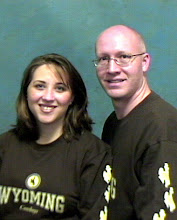This weekend is quickly approaching and we have been trying to get ready for the extraction process. Last year we didn't have an uncapping tank so we tried to tie one of our plastic queen excluders to the top of a big plastic bin. It worked.... kind of. Let's just say it was a pain to use. This year I decided to build my own uncapping tank. Here is how it went:
I started by stealing one of Chris' plastic containers- one of those she usually uses to store old blankets, clothes, etc. I cut a couple of notches just big enough to fit a 2X4 on either side of the container. Then I drilled holes into the sides on both ends a few inches from the top.
I then cut a 2X4 just a little longer than the container is wide and put a screw all the way through about half way up the board.
Next I cut a couple of dowels the same length as the 2X4. I cut some hardware cloth down to size, wrapped the ends of it around the dowels, and laced it together with wire.
I put it all together by setting the hardware cloth down in the container (without the dowels) and then sliding the dowels in through the holes on one side, through the end loops in the hardware cloth, and out the other side. Then I set the 2X4 in its notches with the screw pointing up.
I should be able to place the end of a frame full of honey on the screw, uncap one side, and rotate it around on the screw to uncap the other side. The caps should get caught on the hardware cloth while the honey drips through to the bottom.
I put the 2X4 in the center so I could uncap onto either side of the tank- in retrospect, I wonder if it would have been better to put it further to one end in order to leave more room for the caps to fall. I suppose I can still change it if I need to.
The only thing left is to cut a hole near the bottom and install a honey gate. If this contraption works well I will see about doing that next year.






 The preceding photo shows some nice white new comb but does not show what I was actually looking at. This next photo is a close up of the same frame. Look at what is inside the cells.
The preceding photo shows some nice white new comb but does not show what I was actually looking at. This next photo is a close up of the same frame. Look at what is inside the cells. 






